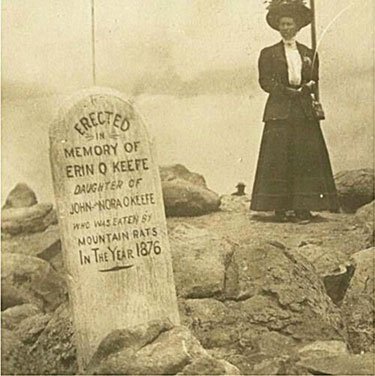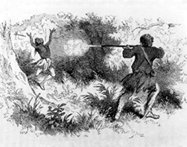“We’re From the Government. We’re Here to Help.”
Animas River, Colorado, EPA, Official Incompetence
If Other Guys Said What Donald Trump Says…
2016 Election, Donald Trump, Satire
Hat tip to Lynn Chu.
Wedge-Tailed Eagle Nails Drone
Aerial Combat, Drone, Wedge-tailed Eagle
It’s Aquila audax, the largest bird of prey in Australia.
These eagles can have wing spreads of up to 7′ 5″ (2.27 m). Pure death on drones.
Slow-motion video:
Via Ratak Mondosico.
“Black and Unarmed”
Crime, Mainstream Media, Media Bias, Michael Brown, Police Shootings, Racial Politics, Washington Post
John Hinderaker commemorates the anniversary of the fatal shooting of Michael Brown with a skeptical response to the WaPo’s agitprop story “Black and Unarmed“.
[T]he constant emphasis on police shootings of *unarmed* men that we see in the press is, for the most part, crazy. If you are a perp, or a suspect, or an inoffensive person walking down the street, you may be unarmed, but the police officer is not. Nor, in most cases, will he have any immediate way to know whether you are armed or not. If you attack him, what do you expect him to do? Challenge you to an arm-wrestling match? He is entitled to use deadly force to defend himself. Attacking a police officer rarely ends well. Likewise with fleeing a police officer who is ordering you to stop.
If there is a problem here, it does not demand a thorough revamping of American police practices. Rather, it suggests that those who have influence with a small demographic group–6% of the population, according to the Post–impress upon them that they should not attack police officers under any circumstances, and if told to stop, they should stop. If they put their hands up, they are not going to get shot.
One last note: the Post casually adds that 18 law officers have been shot and killed by a suspect in the line of duty so far this year. No mention of the race of the officers or of the persons who shot them. Race is only relevant in certain highly selective circumstances, when it can be of political benefit to the party favored by newspaper reporters and editors.
——————————-
Larry Elder points out just how racially-slanted the outrage is.
[A]ccording to the Centers for Disease Control, police shootings of blacks are down almost 75 percent over the last 45 years, while police shooting of whites remained level. And never mind that the media engages in selective concern.
Selective concern?
In just the last two weeks, two cops, who happened to be white, were killed by two suspects, who happened to be black. And an unarmed white teen was killed by a cop. …
In South Carolina, an unarmed teenager was shot and killed by a cop. Zachary Hammond, 19, was out on a first date when he was fatally shot by a Seneca police officer during a drug bust. His date, who was eating an ice cream cone at the time of the shooting, was later arrested and charged with possession of 10 grams of marijuana. The shooting is under investigation. But the police claim Hammond was driving his car toward the police officer who was attempting to make the stop, an act that resulted in the officer firing two shots, striking Hammond in the shoulder and torso.
The Hammond family wonders why so little national attention has been focused on their son’s death. “It’s sad, but I think the reason is, unfortunately, the media and our government officials have treated the death of an unarmed white teenager differently than they would have if this were a death of an unarmed black teen,” said Eric Bland, the family’s attorney.
Tall Tale From the Old West
Black Humor, Colorado, Cryptozoology, Old West, Tall Tales
Pikes Peak was the scene of a fraud perpetrated in 1876 by John O’Keefe, whose job was to take weather readings on the summit and signal them to the city below.
O’Keefe’s tall tale about rats on the peak’s summit was first printed in the Pueblo Chieftain newspaper. The tale then spread to the Rocky Mountain News, which published an articled entitled “Rodents on the Rampage – an Awful and Almost Incredible Story, a Fight for Life with Rats on Pikes Peak.”
In the Rocky Mountain News story, O’Keefe claimed the top of Pikes Peak was overrun by rats the size of cats that fed on “saccharine gum that percolates through the pores of the rocks.”
The story continues:
“Since the establishment of the government’s signal station on the summit of the peak, these animals have acquired a voracious appetite for raw and uncooked meat, the scent of which seems to impart to them a ferocity rivaling the fierceness of the starved Siberian wolf.”
O’Keefe claimed that on his first night at the station, he and his wife were attacked by rats and would have been overwhelmed had they not electrocuted them using electrical wire powered by a battery.
When the battle was over, they discovered the rats had eaten their infant daughter, Erin.
O’Keefe claimed he buried all that was left of Erin (her skull) under a pile of rocks with a marker and this inscription, “Erin O’Keefe, daughter of John and Nora O’Keefe, who was eaten by mountain rats in the year 1876.”
The grave became a popular tourist attraction, and O’Keefe charged 50 cents for tourists to have their picture taken at the site.
O’Keefe was eventually revealed as a fraud. He didn’t have a wife or daughter, and probably buried his dead burro under the rocks.
Via Ratak Monodosico.












